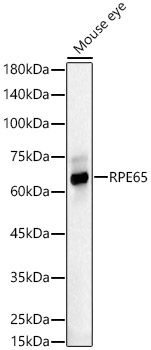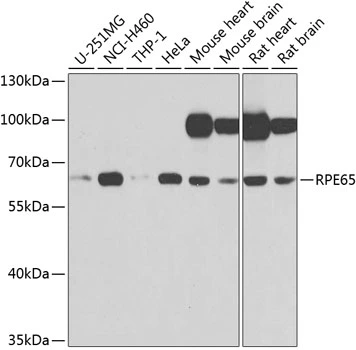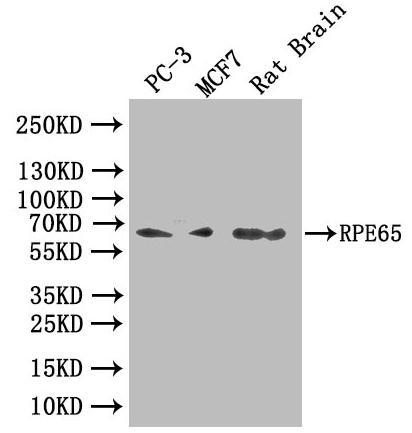RPE65 antibody [HL1519]
GTX636993
ApplicationsWestern Blot, ImmunoHistoChemistry, ImmunoHistoChemistry Paraffin
Product group Antibodies
TargetRPE65
Overview
- SupplierGeneTex
- Product NameRPE65 antibody [HL1519]
- Delivery Days Customer9
- Application Supplier NoteWB: 1:500-1:3000. *Optimal dilutions/concentrations should be determined by the researcher.Not tested in other applications.
- ApplicationsWestern Blot, ImmunoHistoChemistry, ImmunoHistoChemistry Paraffin
- CertificationResearch Use Only
- ClonalityMonoclonal
- Clone IDHL1519
- Concentration1 mg/ml
- ConjugateUnconjugated
- Gene ID6121
- Target nameRPE65
- Target descriptionretinoid isomerohydrolase RPE65
- Target synonymsBCO3, LCA2, RP20, mRPE65, p63, rd12, sRPE65, retinoid isomerohydrolase, BCO family, member 3, RBP-binding membrane protein, RPE65, retinoid isomerohydrolase, all-trans-retinyl-palmitate hydrolase, lutein isomerase, meso-zeaxanthin isomerase, retinal pigment epithelium specific protein 65, retinal pigment epithelium-specific 65 kDa protein, retinal pigment epithelium-specific protein 65kDa, retinitis pigmentosa 20 (autosomal recessive), retinol isomerase
- HostRabbit
- IsotypeIgG
- Protein IDQ16518
- Protein NameRetinoid isomerohydrolase
- Scientific DescriptionThe protein encoded by this gene is a component of the vitamin A visual cycle of the retina which supplies the 11-cis retinal chromophore of the photoreceptors opsin visual pigments. It is a member of the carotenoid cleavage oxygenase superfamily. All members of this superfamily are non-heme iron oxygenases with a seven-bladed propeller fold and oxidatively cleave carotenoid carbon:carbon double bonds. However, the protein encoded by this gene has acquired a divergent function that involves the concerted O-alkyl ester cleavage of its all-trans retinyl ester substrate and all-trans to 11-cis double bond isomerization of the retinyl moiety. As such, it performs the essential enzymatic isomerization step in the synthesis of 11-cis retinal. Mutations in this gene are associated with early-onset severe blinding disorders such as Leber congenital. [provided by RefSeq, Oct 2017]
- Storage Instruction-20°C or -80°C,2°C to 8°C
- UNSPSC12352203






